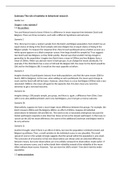Summary
Summary The role of statistics in behavioral research
- Course
- Institution
Summary of The role of statistics in behavioral research written by Sander Los at the Free University of Amsterdam. includes explanations of the t-test and various formulas.
[Show more]



